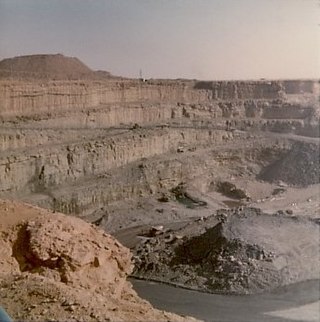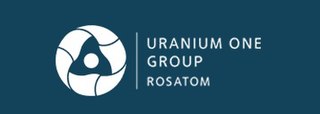Related Research Articles

Areva S.A. is a French multinational group specializing in nuclear power headquartered in Courbevoie, France. Before its 2016 corporate restructuring, Areva was majority-owned by the French state through the French Alternative Energies and Atomic Energy Commission (54.37%), Banque publique d'investissement (3.32%), and Agence des participations de l'État (28.83%). Électricité de France, of which the French government has a majority ownership stake, owned 2.24%; Kuwait Investment Authority owned 4.82% as the second largest shareholder after the French state.

Swakopmund is a city on the coast of western Namibia, 352 km (219 mi) west of the Namibian capital Windhoek via the B2 main road. It is the capital of the Erongo administrative district. As of 2011, the town has 44,725 inhabitants and covers 196 km2 (76 sq mi) of land.

Arlit is an industrial town and capital of the Arlit Department of the Agadez Region of northern-central Niger, built between the Sahara Desert and the eastern edge of the Aïr Mountains. It is 200 km south by road from the border with Algeria. As of 2011, the commune had a total population of 112,432 people.
Orano Cycle, formerly COGEMA and Areva NC, is a French nuclear fuel company. It is the main subsidiary of Orano S.A. It is an industrial group active in all stages of the uranium fuel cycle, including uranium mining, conversion, enrichment, spent fuel reprocessing, and recycling.

The Rössing Uranium Mine in Namibia is the longest-running and one of the largest open pit uranium mines in the world. It is located in the Namib Desert near the town of Arandis, 70 kilometres from the coastal town of Swakopmund. Discovered in 1928, the Rössing mine started operations in 1976. In 2005, it produced 3,711 tonnes of uranium oxide, becoming the fifth-largest uranium mine with 8 per cent of global output. Namibia is the world's fourth-largest exporter of uranium.
Trekkopje is a mountain in the Erongo Region of Namibia, c. 85 kilometres (53 mi) north-east of Swakopmund on the road to Usakos.

The Swakop River is a major river in western central Namibia. Its river source is in the Khomas Highland. From there it flows westwards through the town of Okahandja, the historic mission station at Gross Barmen, and the settlement of Otjimbingwe. It then crosses the Namib desert and reaches the Atlantic Ocean at Swakopmund. The Swakop is an ephemeral river; its run-off is roughly 40 million cubic metres per annum.

Uranium One is an international group of companies, part of the management circuit of the TENEX Group of Rosatom State Corporation. Since 2013, it is a wholly owned subsidiary of Moscow-based Uranium One Group, a part of the Russian state-owned nuclear corporation Rosatom.

Mining is the biggest contributor to Namibia's economy in terms of revenue. It accounts for 25% of the country's income. Its contribution to the gross domestic product is also very important and makes it one of the largest economic sectors of the country. Namibia produces diamonds, uranium, copper, magnesium, zinc, silver, gold, lead, semi-precious stones and industrial minerals. The majority of revenue comes from diamond mining. In 2014, Namibia was the fourth-largest exporter of non-fuel minerals in Africa.

The mineral mining industry is a crucial piece of the Economy of Niger. Exports of minerals consistently account for 40% of exports.

Namibia has one of the richest uranium mineral reserves in the world. There are currently two large operating mines in the Erongo Region and various exploration projects planned to advance to production in the next few years.

Lichens are a composite organism consisting of fungi and algae living in symbiotic relationship. They are well adapted to survive in harsh conditions. One of the many places they can be found is the Namib, the desert that gave Namibia its name. Fog in the coastal parts of the desert provides the necessary moisture for the organisms' survival. In the Namib they grow on shrubs, rocks and pebbles of the gravel plains. These small organisms can densely cover large areas, forming lichen fields.
Nuclear energy in Namibia is a topic of geopolitical interest but is currently not an infrastructure concern. There are no nuclear power plants in Namibia. There is potential interest in the country's nuclear power capacities, as Namibia is the world's fourth-largest uranium producer.

SOMAIR is a national mining company of Niger in the mining area of its northern zone. Established in 1968, it started uranium mining at the Arlit deposit in 1971, mining 0.30 - 0.35% ore down to depth of 60 metres (200 ft) depth. By 1981, the company was producing 2100 tU/yr and by 2006 it was producing 1565 tU at the Tamou deposit. The production peaked to 3065 tU in 2012. The resources, according to the Red Book, are assessed at 23,170 tU, as of 2010, at 42,200 tU of 0.25%U grade recoverable conventionally, and 5500 tU of 0.07%U grade from heap leaching. SOMAIR is one of two national mining companies in Niger, the other being COMINAK in the nearby Akokan.
COMINAK is a national uranium mining company of Niger.
The Imouraren mine is a large mine located in the northern part of Niger in Agadez Region, about 80 km (50 mi) south of Arlit. Imouraren represents one of the largest uranium reserves in Niger having estimated reserves of 109.1 million tonnes of ore grading 0.06% uranium. It is the site of a uranium mining project involving French company Areva and SOPaMin. The U3O8 ore grade at nearby SOMAIR is 14,000 tons at 0.3%, COMINAK is 29,000 t at 0.4% and Imouraren 120,000t at 0.15%.

The Husab Mine, also known as the Husab Uranium Project, is a uranium mine near the town of Swakopmund in the Erongo region of western-central Namibia. The mine is located approximately 60 kilometres (37 mi) from Walvis Bay. The Husab Mine is expected to be the second largest uranium mine in the world after the McArthur River uranium mine in northern Saskatchewan, Canada and the largest open-pit mine on the African continent. Mine construction started in 2014. The Husab Mine started production towards the end of 2016 after completion of the sulfuric acid leaching plant.

Orano SA is a multinational nuclear fuel cycle company headquartered in Châtillon, Hauts-de-Seine, France. The company is engaged in uranium mining, conversion-enrichment, spent fuel recycling, nuclear logistics, dismantling, and nuclear cycle engineering activities. It was created in 2017 as a result of restructuring and recapitalizing of the nuclear conglomerate Areva. Orano is majority owned by the French state. As of September 2021, Orano is the second largest uranium producer in the world with 9% share in global uranium production.
The Erongo Desalination Plant, also known as the Orano Desalination Plant, is a sea water desalination plant in Namibia. The facility was constructed between 2008 and 2010 by Orano Mining Namibia, which at the time was known as Areva Resources Namibia. The desalination plant was established to supply water to Orano’s Trekkopje Uranium Mine. At the time this plant was commissioned, it was the largest reverse osmosis desalination plant in Southern Africa.
References
- ↑ Uranium Commodity Profile
- ↑ "Algeria dreams of nuclear energy (Magharebia.com)". www.magharebia.com. Archived from the original on 12 March 2008. Retrieved 13 January 2022.
- ↑ "afrol News - Angola seeks to increase investments in mining". www.afrol.com. Retrieved 2017-09-18.
- ↑ Benza, Brian (2008-01-09). "Botswana: Twenty Million Pounds of Uranium Discovered At Mokobaesi". Mmegi/The Reporter (Gaborone). Retrieved 2017-09-18.
- ↑ "ACAP Resources". www.acap.com.au. Archived from the original on 9 April 2008. Retrieved 13 January 2022.
- ↑ "Uranium production to double". beta.miningreview.com. Archived from the original on 14 July 2011. Retrieved 13 January 2022.
- ↑ "French nuclear giant to explore potential of uranium deposit in Niger". Africanews. 19 March 2023. Retrieved 4 August 2023.
- ↑ グランのメールレディは安全?口コミはどう?. www.niger-uranium.com (in Japanese). Retrieved 2017-09-18.
- ↑ "Forced Action Mixer - History, Types & Manufacturers of Mixers". www.forcedactionmixer.co.uk. February 6, 2020.
- ↑ "Goldman puts 'for sale' sign on Iran's old uranium supplier". Reuters. Feb 11, 2014. Retrieved 2014-12-01.
- ↑ "Home". firsturanium.com.
- ↑ "SIMMER & JACK (PTY) LTD | HOME". www.simmers.co.za.
- ↑ "Archived copy" (PDF). Archived from the original (PDF) on 2007-05-08. Retrieved 2008-12-30.
{{cite web}}: CS1 maint: archived copy as title (link)